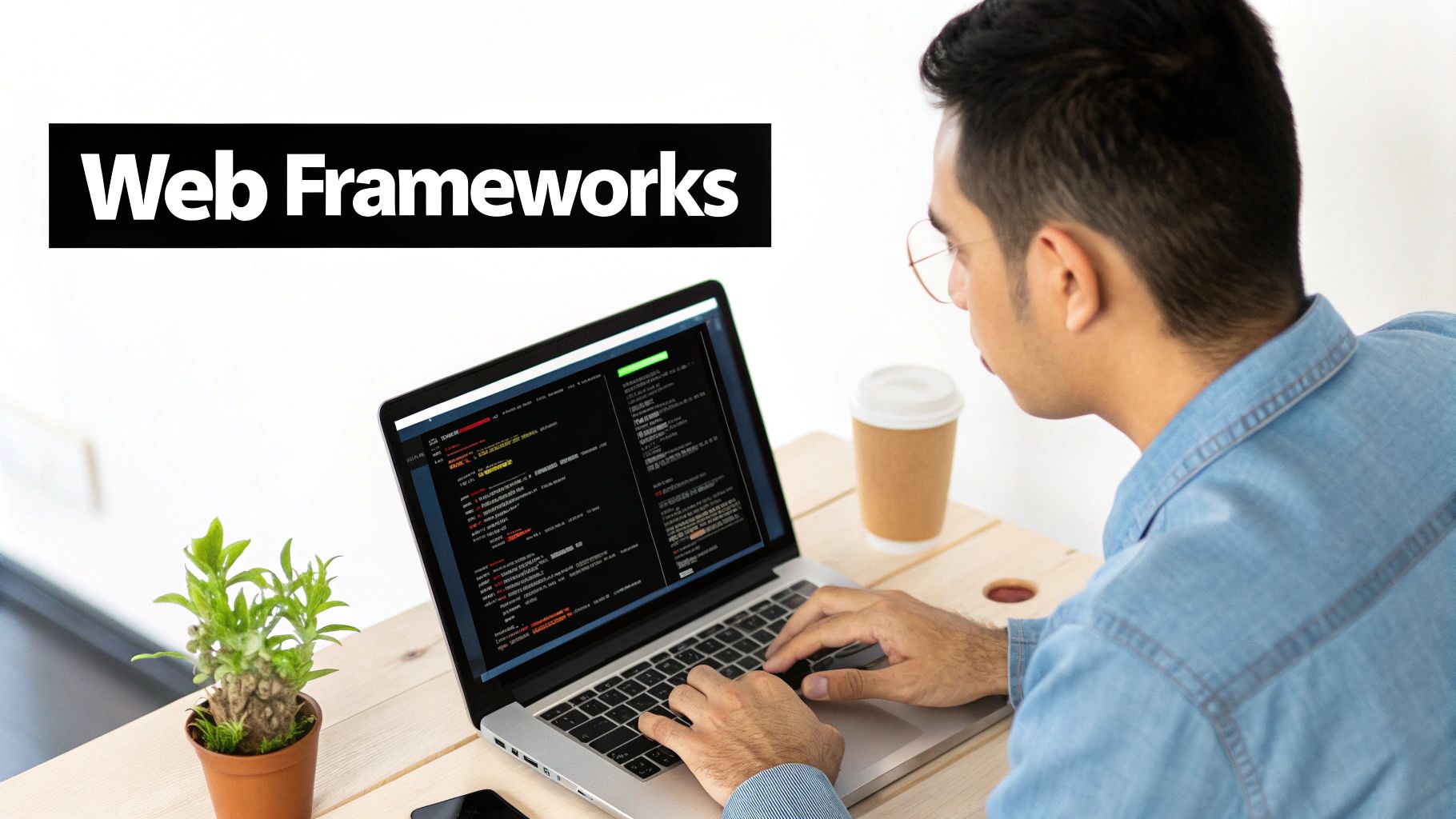What Is a Web Development Framework? A Complete Guide
Learn what is a web development framework, how it works, and how to choose the right one for your project. Get expert advice and simple examples.

Think about building a house from scratch. You could, in theory, chop down your own trees, mill the lumber, and forge every single nail by hand. Or, you could start with a pre-built foundation and frame. A web development framework is that pre-built structure for software. It provides the essential scaffolding so you can focus on building the unique parts of the house—the things that make it a home—instead of reinventing the wheel.
Understanding the Core Concept

At its heart, a framework is a collection of pre-written code, helpful libraries, and ready-to-go tools that give developers a standard, organized way to build web applications. Instead of staring at a blank screen, they start with a solid foundation that already has rules and conventions in place.
This isn't just a time-saver; it’s about quality and consistency. Frameworks offer battle-tested solutions for the complex but common problems every web application faces.
What Frameworks Handle for You
This means developers get to skip the grunt work of building fundamental features from the ground up. Here’s a look at some of the heavy lifting a framework typically manages:
- Routing: It figures out what content to show when a user visits a specific URL, like
/aboutor/contact. - Database Interaction: It makes talking to a database—saving user info, retrieving product details—much simpler and safer.
- Security: Good frameworks come with built-in defenses against common online threats like SQL injection and cross-site scripting (XSS).
- User Authentication: It handles all the tricky parts of user logins, sessions, and permissions so you don't have to.
A framework acts as a guide, providing a clean and organized architecture. This ensures the final app is not only built faster but is also more secure, easier to scale, and far less painful to maintain down the road.
Ultimately, picking a framework is a strategic move. It lets your team jump right into crafting the features that matter to your users, boosting efficiency and ensuring everyone on the project is speaking the same language.
The Real Benefits of Using a Framework

Choosing a web framework instead of coding everything from scratch isn't just about making life easier. It's a strategic move with some very real upsides. The most obvious win is a massive boost in development speed. Frameworks give you a head start by providing all the foundational code, so you don't have to reinvent the wheel for every project.
This speed means you can build, test, and launch features much faster, which directly translates to lower costs and getting your product out the door sooner. For any business, that's huge. It's no wonder the global market for web frameworks is expected to hit around $212.8 billion by 2029. Companies are leaning on these tools more and more to get things done right and on time.
But it’s not just about going fast. Frameworks also offer solutions that have been tested and improved by thousands of developers, resulting in applications that are far more solid and dependable.
Enhanced Security and Code Quality
Web security is a massive deal, and this is where frameworks really shine. They come with built-in defenses against common online threats like SQL injection and cross-site scripting (XSS). This means your developers don’t have to be security gurus from day one; the framework is already watching their back.
This structured environment also leads to better, cleaner code. Frameworks guide developers to follow specific patterns and rules, which keeps the entire project consistent and easy for anyone on the team to navigate.
By providing a standardized structure, a framework makes code more maintainable and scalable. When a new developer joins the team, they can get up to speed quickly because the project follows predictable conventions.
Ultimately, this structure delivers a few key improvements:
- Reduced Bugs: With standardized code and pre-built components that have been tested to death, you’ll see far fewer errors in the finished product.
- Easier Maintenance: When you need to add a feature or squash a bug later, the organized structure makes it simple to find and change the right piece of code.
- Community Support: Popular frameworks have huge, active communities behind them. That means access to constant bug fixes, security updates, and incredible documentation.
Frameworks also make building complex, modern applications feel much less daunting. For example, creating things like Progressive Web Apps is way more straightforward when you have the tools and patterns a good framework provides.
Front End vs. Back End Frameworks
Think of a website like a restaurant. You have the part the customer sees—the dining room, the decor, the menu. That's the "front end." Then you have the part they don't see—the kitchen, the storage, the chefs working their magic. That's the "back end."
In web development, frameworks are specialized for one side or the other.
Front End Frameworks: The User's World
Front end frameworks (also called client-side frameworks) are all about what you see and interact with in your browser. They build the user interface (UI) and shape the user experience (UX). Everything from the layout of the page and the buttons you click to the forms you fill out is handled by a front-end framework.
The main goal here is to create a visually engaging and responsive experience that feels natural to the user.
Back End Frameworks: The Engine Room
On the flip side, back end frameworks (or server-side frameworks) do all the heavy lifting behind the scenes. They’re the engine that makes the website actually work.
These frameworks manage the application's core logic, connect to the database, handle user logins, and keep everything secure. Without a solid back end, the beautiful front end is just a pretty, non-functional picture.
To make this distinction crystal clear, here’s a quick breakdown of their different roles.
Front End vs. Back End Frameworks at a Glance
| Aspect | Front End Frameworks (Client Side) | Back End Frameworks (Server Side) |
|---|---|---|
| Main Job | Build the visual interface and user experience (what users see and interact with). | Power the server, application logic, and database. |
| Concerns | UI/UX design, responsiveness, interactivity, animations, and how data is displayed. | Data storage, security, user authentication, business logic, and server performance. |
| Languages | Primarily JavaScript, HTML, CSS. | Python, Ruby, PHP, Java, JavaScript (Node.js). |
| Examples | React, Angular, Vue.js | Django, Ruby on Rails, Laravel, Express.js |
Essentially, the front end is the "show," and the back end is the "go." They have to work together perfectly to create a seamless experience.
Popular Frameworks by the Numbers
When it comes to the front end, a few major players dominate the field. The chart below shows just how popular they are among developers.
As you can see, React is the clear leader, with its adoption rate sitting at over double that of its next closest competitor, Angular.
On the back end, you'll find powerful tools like Django (built with Python) and Express (for Node.js) running some of the biggest applications on the web. They are the workhorses that handle everything from processing payments to managing user profiles.
If you're curious about diving into the server-side of things, exploring options for Python web application development is a great place to start. It’s a versatile and powerful language that’s incredibly popular for building robust back-end systems.
Popular Web Frameworks in the Real World
Theory is one thing, but seeing frameworks in action is where it all clicks. The world's biggest companies aren't building their massive websites from scratch; they're using these tools to solve complex problems at a global scale.
Let's look at two titans of the industry, Django and Next.js, to see how different frameworks are used out in the wild.
Django, a high-level Python framework, is famous for its "batteries-included" approach. Think of it as a complete toolkit for building the back end of a web application. It comes with everything you need right out of the box, from a ready-made admin panel to powerful security features. This is exactly why a company like Instagram relies on Django to manage its enormous database and handle millions of user interactions every second.
Next.js: The Front-End Powerhouse
On the other side of the coin, we have Next.js, which has become a dominant force for building what users actually see and interact with—the front end. Built on top of the popular React library, Next.js is designed to create incredibly fast, SEO-friendly websites.
Its secret weapon is a feature called server-side rendering (SSR), which dramatically speeds up how quickly a page appears on your screen. This is why Netflix uses Next.js. They need to deliver a buttery-smooth, high-performance experience to keep millions of users engaged, and Next.js helps them do just that.
Of course, Django and Next.js are just two pieces of a much larger puzzle. Microsoft’s ASP.NET, for example, powers around 591,000 websites, capturing 37% of the tracked market. Next.js isn't far behind, with about 390,000 sites, giving it a 25% market share.
The best framework is always the one that best fits the job. Django is a beast for building feature-rich, data-heavy back ends, while Next.js is the go-to for creating blazing-fast and scalable front-end experiences.
Solving Different Problems at Scale
These examples really show how frameworks are chosen to solve specific business needs. Instagram needed a rock-solid, secure, and scalable back end that could keep up with its explosive growth—Django was the perfect tool for the job. Netflix, on the other hand, needed a front end that could deliver content with lightning speed. For them, Next.js was the obvious choice.
Ultimately, figuring out the problem you're trying to solve is the first and most important step in finding the best framework for your web application.
And it doesn't stop with traditional websites. There are even specialized Progressive Web App frameworks that help developers build websites that feel and behave just like native mobile apps. This just goes to show how flexible these tools are, providing pre-built solutions for just about any digital product you can imagine.
How to Choose the Right Framework

Picking the right framework can feel overwhelming, but it gets a lot easier when you know what to look for. The trick is to find the tool that fits your project, not try to shoehorn your project into a trendy tool.
First things first, what are you actually building? A simple, clean marketing site has completely different needs than a massive e-commerce platform built for thousands of concurrent users. A small, lightweight framework is perfect for the former, while a robust, "batteries-included" option is a much safer bet for the latter.
Next up is your team. What do they already know? If your developers are Python wizards or JavaScript experts, sticking with a framework in that language is a massive head start. You’ll slash the learning curve and get building faster, which is always a win.
Key Factors to Evaluate
Beyond the project and your team, you need to think long-term. Choosing a framework is a big commitment, so you want to be sure it can grow with you.
Here are the big things to consider:
- Scalability: Will this framework buckle under pressure when your user base explodes? Look for frameworks with a proven track record of handling high traffic and growing complexity. You don't want to be forced into a total rewrite a year from now.
- Community and Support: An active community is your best friend. It means plenty of tutorials, quick answers on forums, and a huge library of third-party packages to solve common problems for you.
- Documentation: Don't overlook the docs! Clear, well-written documentation is priceless. It’s what your team will rely on day in and day out, and it can save you hundreds of hours of frustration.
In the end, picking a framework is about setting the foundation for your entire project. It's a balancing act between what you need right now, what your team can deliver, and where your business is headed.
Making a smart choice today saves you from a world of technical debt tomorrow. For a more detailed guide on this, check out our post on how to choose a technology stack.
A Few Common Questions About Web Frameworks
As you dig into the world of web frameworks, a few questions always seem to pop up. Let's tackle them head-on to clear up any confusion and help you figure out what's next.
Can I Just Build a Website Without a Framework?
You sure can. For a simple website—maybe a personal portfolio or a small business brochure site—writing everything from scratch with plain HTML, CSS, and JavaScript (what developers often call "vanilla JS") is a perfectly fine approach. It's lightweight and gets the job done.
But here's the catch: the moment your project gets more complicated, you'll feel the pain. Imagine building an online store, a social media app, or any site with complex user interactions from the ground up. You’d spend ages reinventing the wheel, writing code for things like URL routing, database connections, and user security—all problems that frameworks have already solved for you.
How Do Front-End and Back-End Frameworks Actually Work Together?
Think of it like a restaurant. The back-end framework (like Django or Express) is the kitchen. It’s where all the heavy lifting happens: managing the database of ingredients, handling orders (user requests), and cooking up the data. It's the engine running the whole operation behind the scenes.
The front-end framework (like Next.js or Vue) is the dining room—everything the customer sees and interacts with. It takes the "food" prepared by the kitchen and presents it beautifully on the plate. These two sides talk to each other constantly through an API, which acts like the waiter, ensuring a smooth and seamless experience from kitchen to table.
It can be tough deciding which frameworks to learn first. While trends are always shifting, it's interesting to see that Node.js is currently used by 40.8% of developers, with React.js close behind at 39.5%. This really shows how dominant JavaScript is across the entire web development stack. You can discover more insights about web technology usage on Statista.com.
Ready to build a high-performance, scalable web application without the guesswork? At 42 Coffee Cups, we specialize in Next.js and Django development, helping businesses like yours accelerate growth and deliver exceptional digital products. Contact us today to get started.